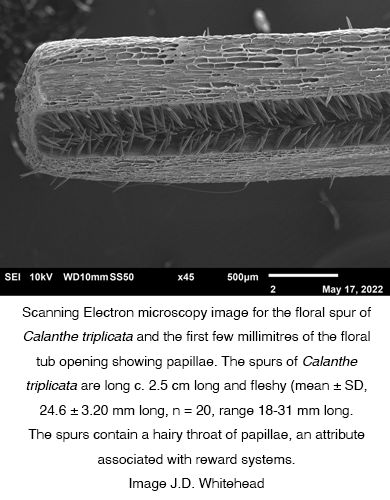<< BACK TO PROJECT LIST
Project: 335/2020
Title: Do some food-deceit orchids actually provide a hidden food reward?
Applicant: Professor Caroline Gross & Dr K. David Macka
Institution: University of New England, Armidale NSW
Food-deceptive orchids are an enigma because in the absence of mimicry, the selective pressures maintaining their highly modified flowers (e.g. false nectary-spurs, colour changes) are unresolved. Charles Darwin (1862) questioned the validity of the food-deceit hypothesis for some orchids from which he could wring the copious liquid contained within the floral tissues, writing “We cannot believe in so gigantic an imposture” (Darwin, 1862 p. 46 in Darwin C. 1862. On the Various Contrivances by which British and Foreign Orchids are Fertlised by Insects And on the Good Effects of Intercrossing. John Murray, London). Numerous hypotheses have been proposed and/or tested but the scientific community is no closer, though, to explaining the phenomenon in systems lacking the components of a Batesian mimetic ménage à trois (model, mimic and signal receiver). Using Calanthe triplicata and C. zollingeri as models, we have discovered that the spurs of these species provide amino acids to visitors and that this important nutritional supplement is accessed by a number of butterflies that pollinate the orchids. In this study further field work time will be used to manipulate flowers to understand the behaviour of butterflies (and possible moths) at flowers and to understand the morphology and anatomy of spurs.

Research Outcomes
Our aim was to determine if the putative food deceptive orchid Calanthe triplicata [Orchidaceae] offers any reward for pollinators contrary to the long held belief that such nectarless species are food deceptive.
We have discovered that Calanthe triplicata conceals large volumes (c. 0.2 ml) of a clear liquid in the tissues of the floral spur that when extracted stains positively and strongly for amino acids. This liquid is produced from the fleshy spur tissue and SEM results suggest that it is secreted from the inner epidermal cells and that on occasion butterflies pierce these cells. The liquid does not form a reservoir in the spur but is present as a thin exudate on the inner epidermal cells of the spur. Large volumes can be retrieved from the spur by crushing it, much as Darwin found with several species of Ophrys (Darwin 1862*). We also found amino acid-rich liquid in the spurs of Calanthe zollingeri, a terrestrial orchid from the lowland rainforest of north Borneo. We found butterflies to be the main floral visitors and they appeared to be accessing a food reward from the floral spurs while transferring pollinia.

* Darwin, C. 1862. On the Various Contrivances by which British and Foreign Orchids are Fertilised by Insects And on the Good Effects of Intercrossing. John Murray, London.
